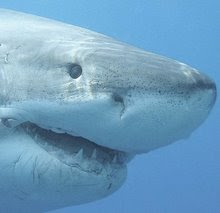Little did I suspect that I would soon be leaving the world of my misguided beliefs, and traversing the boundaries of the 'disaster zone'.
Disaster #1
On the ferry heading out from Long Beach, my first clue was the smell of diesel smoke, and the brown haze stretching as far as the eye could see around the coastline and out to sea. I'd read about the environmental problems of diesel pollution at the Port of Los Angeles, but it had never looked (or smelled) this awful to me before.
It looked for all the world like another series of forest fires were sending smoke tendrils out to sea. This impression could have been due to a winter-time temperature inversion, which traps smog in a thick layer closer to the ground rather than allowing it to mix. If so, it was truly an eye-opening and serendipitous re-introduction to a continuing disaster.
Disaster #2
Casino Point Dive Park, first dive. Upon entering the water my usual euphoria at being back in the sea was rudely erased by a shocking sight: Where did the bottom go? A solid wall of brown 'weeds' filled my view, where once I would have seen rocky reefs covered with close-fitting algae and abundant life.
As it turns out, these 'weeds' are an invasive species of kelp from Japan, called Sargassum muticum. This invader has been around for a while now, but has only begun 'taking over' the seascape within the past few years. It's so thick in the winter months at some spots now (like the Dive Park), that it cuts off bottom-dwelling native life from essential sunlight.
Luckily, it dies off over the summer leaving the native life a chance to recoup a bit. Still, it's getting thicker and more widely spread every winter. This was my first view of it and, just like the diesel smog at Long Beach, it was truly eye-opening.
As if this invasion was not bad enough, things may yet get worse: another invasive species from Japan, Undaria pinnatifida, has also been spotted at dive sites around Catalina. If anything, it is potentially more lethal to native kelps and other life than S. muticum.
Return from the 'disaster zone'
My dive trip turned out OK, even with the unwanted and unplanned education in eco-disaster. Below 50 feet the 'weeds' thinned out to nothing, and all was well in the underwater world.
The ferry ride back to Long Beach was smooth and much less diesel haze was in view.
My relief at this reprieve, both below and above water, was nonetheless tinged with a bit of sadness at what may yet be lost.





No comments:
Post a Comment